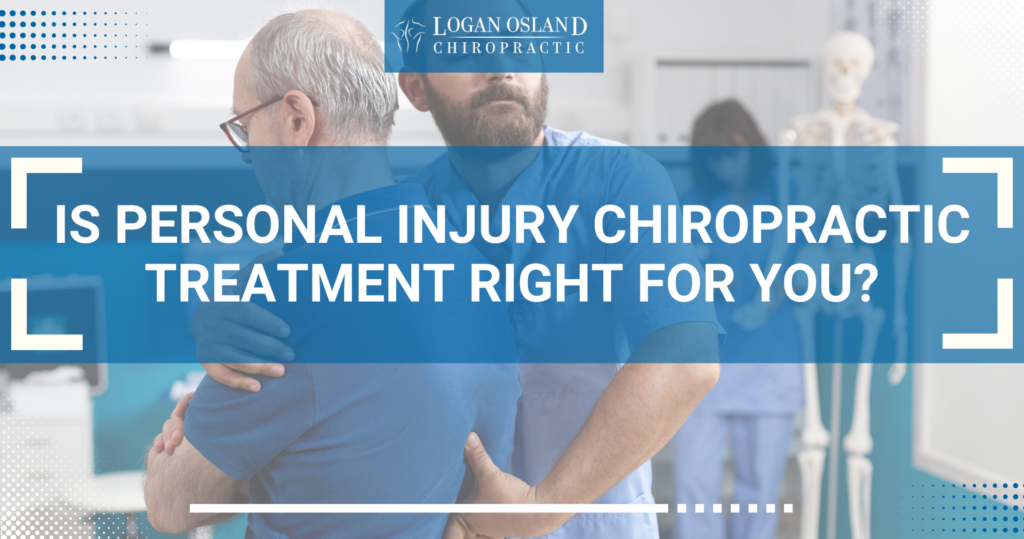If you’ve suffered a personal injury (whatever the cause) you are probably dealing with lingering pain, stiffness, or limited mobility. These issues can make even the simplest daily activities feel challenging, affecting your work, sleep, and overall quality of life.
Conventional treatments like pain medication and surgery are common and useful, but they often focus just on symptom management rather than addressing the root cause of the pain. Chiropractic care, on the other hand, is a natural, non-invasive approach to healing that supports the body’s ability to recover.
One of the most rewarding aspects of my job is helping patients regain mobility and alleviate pain without relying on medication or invasive procedures. I’ve treated patients who were told surgery was their only option, yet with consistent chiropractic care, they found long-term relief and improved function.
Let’s explore how it can help you get back to doing what you love, pain-free.
Understanding Personal Injury and Chiropractic Care
A personal injury is any harm or damage inflicted on the body, often caused by an accident, fall, or trauma. These injuries typically affect the musculoskeletal system, resulting in pain, swelling, and reduced movement. Personal injuries can range from minor strains and sprains to more severe conditions like fractures or torn ligaments. Some of the most common types of personal injuries include:
- Auto accident injuries – whiplash injuries, back pain, and joint misalignment.
- Workplace injuries – repetitive strain injuries, falls, and heavy lifting injuries.
- Slip and fall injuries – spinal misalignment and joint dysfunction.
- Sports injuries – sprains, strains, and overuse injuries.
Personal injury chiropractors use hands to gently adjust the spine and other joints, helping to realign the body and reduce pain, similar yet much more influential than massage. We often include complementary therapies as well (manipulation, exercises, and lifestyle advice.)
Common Personal Injuries That Can Benefit from Chiropractic Treatment
These are some of the most common personal injuries that can benefit from chiropractic adjustment.
1. Whiplash and Auto Accident Injuries
Car accidents (especially rear-end collisions) are a major cause of whiplash, a condition that occurs when the head is forcefully jerked forward and backward. This sudden movement strains the muscles, ligaments, and tendons in the neck. The consequences are usually stiffness, headaches, dizziness, and even radiating pain in the shoulders and arms. Whiplash often hurts the spine’s natural alignment, which can lead to long-term discomfort if left untreated.
How Chiropractic Helps:
- Gentle spinal adjustments to realign the neck and relieve pressure on nerves.
- Soft tissue therapy to reduce muscle tension and inflammation.
- Targeted exercises to restore range of motion and strengthen supporting muscles.
2. Workplace Injuries (Repetitive Strain, Lifting Injuries, etc.)
Many workplace injuries develop over time due to repetitive motions, poor ergonomics, and/or heavy lifting. Sitting at a desk all day can cause neck and back strain, while jobs that require frequent lifting or bending lead to muscle imbalances and spinal misalignments. Overuse injuries, such as carpal tunnel syndrome or tendinitis, are also common among office workers and manual laborers alike.
How Chiropractic Helps:
- Postural corrections and ergonomic advice to reduce strain on the spine.
- Spinal adjustments to relieve pressure on compressed nerves and improve mobility.
- Strengthening exercises and stretches for a patient to enhance stability and prevent recurring injuries.
3. Slip and Fall Injuries
Falls are one of the leading causes of personal injuries. Sprains, fractures, and spinal misalignments are sometimes unavoidable. The problem is that a seemingly minor fall can create hidden joint dysfunctions, not to mention more serious things. The impact of a fall can shift vertebrae out of alignment, irritate nerves, and cause muscle stiffness, too.
How Chiropractic Helps:
- Spinal manipulation and neck adjustments to restore proper alignment and relieve nerve irritation.
- Joint mobilization techniques to improve flexibility and range of motion.
- Balance training and coordination exercises to strengthen stabilizing muscles and prevent future falls.
4. Sports-Related Injuries
Athletes put their bodies through intense physical stress, making muscle strains, ligament sprains, and joint inflammation practically everyday things. Overuse conditions like tennis elbow or runner’s knee are equally present. Without proper treatment, these injuries will become chronic and limit performance. Chiropractic care is used by professional athletes more and more.
You don’t have to be a pro athlete to benefit. If you play weekend tennis or a basketball league, those are equally big efforts for a regular person.
How Chiropractic Helps:
- Manual adjustments to improve joint mobility and correct misalignments.
- Physical therapy, such as myofascial release, breaks up adhesions and reduces inflammation.
- Personalized strengthening programs to support muscle recovery and boost athletic performance.
5. Post-Surgical Recovery Support
While chiropractic care is not a replacement for surgery, it can play a role in post-operative rehabilitation. After orthopedic procedures the body often experiences stiffness, muscle imbalances, and restricted movement. Chiropractic techniques facilitate a smoother recovery process while reducing pain and improving function.
How Chiropractic Helps:
- Gentle adjustments to avoid unnecessary stress on healing tissues and promote proper spinal alignment.
- Soft tissue therapies break up scar tissue, improve circulation, and accelerate healing.
- Rehabilitation exercises to regain strength, flexibility, and coordination after surgery.
Key Benefits of Chiropractic Care for Personal Injury Recovery
The key benefits of chiropractic care that make it an invaluable part of personal injury recovery are:
- Drug-Free Pain Relief: One of the major advantages of chiropractic care is that it provides drug-free pain relief. Many personal injuries come with the temptation to rely on painkillers to dull the discomfort, but this approach only masks the symptoms. Chiropractic adjustments, on the other hand, allow you to avoid the side effects of prescription pain relievers and get a more sustainable recovery.
- Improved Mobility: After a personal injury, you may experience limited movement or stiffness in the affected area, which can impact daily tasks and overall quality of life. We can help you regain lost mobility faster.
- Faster Healing: When a joint, muscle, or ligament is misaligned or under stress, it can hinder the body’s natural healing process. Reduced inflammation and improved circulation give the body a chance to heal more efficiently.
- Long-Term Injury Prevention: One of the most significant benefits of chiropractic care is its ability to prevent future injuries. Once the body has healed from an injury, many people fall into the trap of returning to their normal activities without correcting the imbalances that led to the injury in the first place.
Is Chiropractic Treatment Right for You? Factors to Consider
Chiropractic care is highly effective for a wide range of personal injuries, but it’s essential to consider a few key factors before deciding if it’s the right approach for you. We can also help you make decisions and factors that have major influence.
The Severity of Your Injury
The severity of your injury, of course, plays a crucial role. For minor injuries, such as soft tissue injuries, muscle strains, or mild joint pain, chiropractic care can often provide immediate relief and aid in a swift recovery. However, more severe injuries, such as fractures, dislocations, or spinal cord damage, probably require additional medical interventions.
In these cases, chiropractic treatment is still beneficial as part of a comprehensive treatment plan.
Your Overall Health
Before starting personal injury treatment, it’s important to think about your overall health and any pre-existing conditions that may affect your treatment options. Osteoporosis, spinal infections, or advanced arthritis are contraindicated for some chiropractic adjustments, as they could pose a risk of injury or exacerbate the condition.
If you have high blood pressure, diabetes, or a history of cardiovascular disease, it’s necessary to share these details with your chiropractor. It is generally safe for most people with those conditions, but your overall health can influence the techniques used.
Wrapping Up
Recovering from a personal injury does not have to mean surgery or long-term reliance on painkillers.
Don’t let an injury dictate how you live your life. With the right chiropractic approach, you can regain your strength, restore your mobility, and get back to doing everyday things or even sports.
If you’re struggling with pain, stiffness, or restricted movement after an injury, seeking chiropractic care sooner rather than later can make all the difference. A skilled personal injury chiropractor will create a plan and eventually fix your problems. If you’re ready to take control of your recovery, give us a call.
Frequently Asked Questions
How soon after a personal injury should I see a chiropractor?
The sooner you seek chiropractic care after a personal injury, the better. Early treatment can prevent minor issues from turning into chronic pain and speed up recovery. Even if you’re not feeling severe pain right away, a chiropractor can assess hidden injuries that may worsen over time.
Can chiropractic treatment help with nerve pain from a personal injury?
Yes, chiropractic adjustments can relieve nerve pain by reducing pressure on irritated nerves. Misalignments in the spine or joints can compress nerves, leading to pain, numbness, or tingling.
Do I need a referral from a doctor to see a chiropractor for a personal injury case?
In most cases, you don’t need a referral to see a chiropractor. Chiropractors are primary healthcare providers, meaning you can book an appointment directly. However, if your injury is part of a legal or insurance claim, checking specific requirements for personal injury lawsuit may be helpful.
Will chiropractic care help with long-term pain from an old personal injury?
Even years after an injury, chiropractic can help manage pain and improve mobility. Chronic pain is often linked to unresolved spinal misalignments or scar tissue buildup.
Does chiropractic care only focus on the spine, or can it help with other joints?
While chiropractic care is known for spinal adjustment, it also treats other joints like shoulders, knees, wrists, and hips. Many personal injuries affect multiple areas of the body, and chiropractic techniques can restore function beyond just the spine.
References
Woodward MN, Cook JC, Gargan MF, Bannister GC. Chiropractic treatment of chronic ‘whiplash’ injuries. Injury. 1996 Nov;27(9):643-5. doi: 10.1016/s0020-1383(96)00096-4. PMID: 9039361.
Dies S, Strapp JW. Chiropractic treatment of patients in motor vehicle accidents: a statistical analysis. J Can Chiropr Assoc. 1992 Sep;36(3):139–45. PMCID: PMC2484939.
Whedon JM, Mackenzie TA, Phillips RB, Lurie JD. Risk of traumatic injury associated with chiropractic spinal manipulation in Medicare Part B beneficiaries aged 66 to 99 years. Spine (Phila Pa 1976). 2015 Feb 15;40(4):264-70. doi: 10.1097/BRS.0000000000000725. PMID: 25494315; PMCID: PMC4326543.


